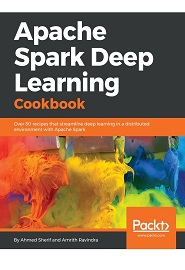
English | 2018 | ISBN: 978-1788474221 | 474 Pages | PDF, EPUB | 1141 MB
Apache Spark Deep Learning Cookbook: Access to 80 enriched recipes that streamline deep learning in a distributed environment with Apache Spark
A solution-based guide to put your deep learning models into production with the power of Apache Spark
With deep learning gaining rapid mainstream adoption in modern-day industries, organizations are looking for ways to unite popular big data tools with highly efficient deep learning libraries. As a result, this will help deep learning models train with higher efficiency and speed.
With the help of the Apache Spark Deep Learning Cookbook, you’ll work through specific recipes to generate outcomes for deep learning algorithms, without getting bogged down in theory. From setting up Apache Spark for deep learning to implementing types of neural net, this book tackles both common and not so common problems to perform deep learning on a distributed environment. In addition to this, you’ll get access to deep learning code within Spark that can be reused to answer similar problems or tweaked to answer slightly different problems. You will also learn how to stream and cluster your data with Spark. Once you have got to grips with the basics, you’ll explore how to implement and deploy deep learning models, such as Convolutional Neural Networks (CNN) and Recurrent Neural Networks (RNN) in Spark, using popular libraries such as TensorFlow and Keras.
By the end of the book, you’ll have the expertise to train and deploy efficient deep learning models on Apache Spark.
What You Will Learn
- Set up a fully functional Spark environment
- Understand practical machine learning and deep learning concepts
- Apply built-in machine learning libraries within Spark
- Explore libraries that are compatible with TensorFlow and Keras
- Explore NLP models such as word2vec and TF-IDF on Spark
- Organize dataframes for deep learning evaluation
- Apply testing and training modeling to ensure accuracy
- Access readily available code that may be reusable
Resolve the captcha to access the links!